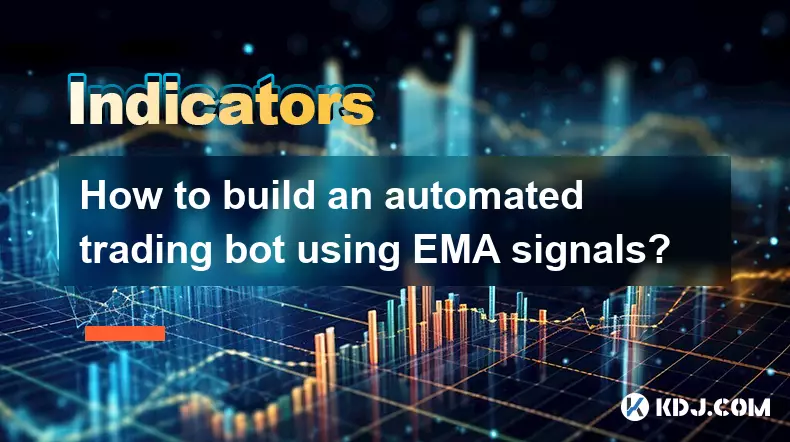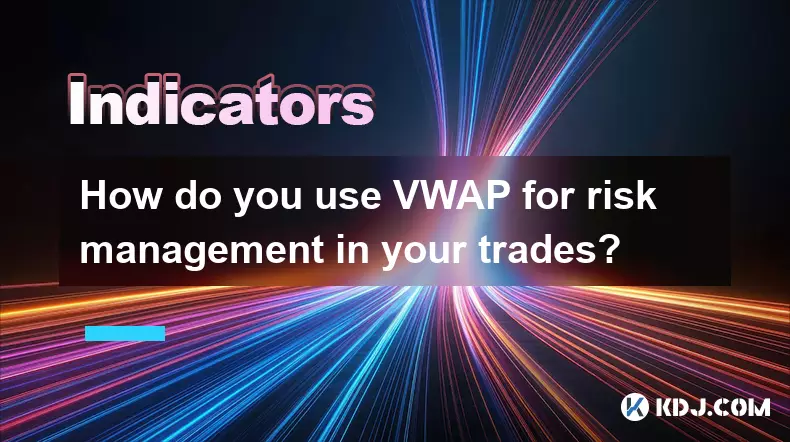-
 bitcoin
bitcoin $114684.631706 USD
-0.87% -
 ethereum
ethereum $4228.677447 USD
1.58% -
 bnb
bnb $1294.880693 USD
-1.16% -
 tether
tether $1.000819 USD
-0.02% -
 xrp
xrp $2.605138 USD
2.79% -
 solana
solana $209.908690 USD
5.89% -
 usd-coin
usd-coin $0.999903 USD
-0.03% -
 dogecoin
dogecoin $0.213423 USD
2.93% -
 tron
tron $0.322721 USD
-0.10% -
 cardano
cardano $0.727247 USD
3.66% -
 hyperliquid
hyperliquid $42.339456 USD
6.05% -
 chainlink
chainlink $19.910811 USD
5.16% -
 ethena-usde
ethena-usde $1.000557 USD
0.00% -
 stellar
stellar $0.349734 USD
2.69% -
 bitcoin-cash
bitcoin-cash $543.848687 USD
-0.21%
How to build an automated trading bot using EMA signals?
An EMA-based crypto trading bot uses weighted moving averages to detect trends early, with faster signals than SMA, ideal for volatile markets.
Oct 13, 2025 at 05:18 am

Understanding EMA and Its Role in Crypto Trading
1. The Exponential Moving Average (EMA) is a type of moving average that places greater weight on recent price data, making it more responsive to new information compared to the Simple Moving Average (SMA). This responsiveness makes EMA particularly useful in the fast-moving cryptocurrency markets where price shifts can occur within minutes.
2. Traders commonly use specific EMA combinations such as the 9-period and 21-period EMAs to identify short-term momentum. When the shorter EMA crosses above the longer one, it generates a bullish signal; when it crosses below, it indicates bearish momentum.
3. In automated trading systems, these crossovers are coded as triggers for buy or sell actions. The bot continuously monitors price candles and calculates EMAs in real time, enabling immediate execution once a crossover condition is met.
4. Because EMA reacts faster to price changes, it helps bots enter trends earlier than lagging indicators. However, this sensitivity also increases the risk of false signals during volatile sideways markets.
5. To improve reliability, many developers combine EMA strategies with volume filters or volatility thresholds, ensuring trades only execute under confirmed market conditions rather than noise.
Designing the Core Logic of an EMA-Based Bot
1. The foundation of any EMA-driven bot lies in its signal detection algorithm. Developers must define the EMA periods—common pairs include 12/26 for MACD-based logic or 50/200 for trend confirmation—and program the system to compute these values from live OHLCV (Open, High, Low, Close, Volume) data.
2. A typical entry rule might state: 'Buy when EMA(9) crosses above EMA(21) and close price is above both averages.' Conversely, a sell signal could be triggered when the 9-period EMA drops below the 21-period line.
3. Code implementation often uses libraries like Pandas and NumPy in Python to handle data processing efficiently. Real-time updates can be achieved via WebSocket connections to exchanges such as Binance or Bybit.
4. Position management includes setting predefined position sizes, stop-loss levels based on recent volatility (e.g., ATR), and take-profit targets tied to support/resistance zones or trailing stops.
5. Risk control mechanisms should be embedded directly into the logic. For example, the bot may skip trades if overall market volatility exceeds a threshold or if the account equity has dropped beyond a daily limit.
Backtesting and Optimization Strategies
1. Before deploying live, every EMA bot must undergo rigorous backtesting using historical candlestick data across multiple crypto assets like BTC/USDT, ETH/USDT, and altcoin pairs.
2. Backtesting frameworks such as Backtrader or Freqtrade allow developers to simulate how the bot would have performed over past market cycles, including bull runs, corrections, and consolidation phases.
3. Key performance metrics include win rate, profit factor, maximum drawdown, and Sharpe ratio. These help assess whether the EMA strategy provides consistent returns relative to its risk exposure.
4. Parameter optimization involves adjusting EMA lengths, trade frequency filters, and slippage assumptions to find the most robust configuration without overfitting to historical noise.
5. Walk-forward analysis—where models are retrained on rolling windows of data—helps verify that the bot adapts well to evolving market dynamics instead of relying on static patterns.
Deployment and Monitoring Considerations
1. Once validated, the bot can be deployed on cloud servers (e.g., AWS, Google Cloud) to ensure 24/7 uptime and low-latency access to exchange APIs.
2. Secure API keys with restricted permissions (trade-only, no withdrawal access) must be used to minimize security risks. Encryption of credentials and regular key rotation enhance protection against breaches.
3. Real-time monitoring dashboards display active positions, executed trades, P&L, and signal status. Alerts can be configured via email or Telegram when unusual behavior occurs, such as repeated failed orders or disconnection from the exchange.
4. Latency-sensitive strategies benefit from colocated servers near exchange data centers, reducing execution delays that could impact profitability, especially in high-frequency setups.
5. Regular audits of trade logs help detect anomalies or bugs. Logging every decision point—including EMA values at the time of trade—enables forensic analysis after unexpected outcomes.
Frequently Asked Questions
What timeframes work best for EMA-based crypto bots?Shorter timeframes like 5-minute or 15-minute candles suit scalping bots using fast EMAs (e.g., 9 and 21). Longer-term swing bots often perform better on hourly or 4-hour charts with slower EMAs such as 50 and 200.
Can EMA crossovers alone generate profitable trades?While EMA crossovers provide clear signals, relying solely on them can lead to losses during choppy markets. Combining them with additional filters—like RSI divergence or volume spikes—improves accuracy and reduces whipsaws.
How do I prevent my bot from overtrading?Implement cooldown periods after each trade, require minimum trend strength before entering, and apply filters based on average daily range. These constraints reduce unnecessary entries during low-momentum phases.
Is it safe to run an automated bot with real funds?Safety depends on proper risk management and testing. Start with small capital allocations, use paper trading first, and ensure emergency shutdown protocols are in place to halt operations if abnormal losses occur.
Disclaimer:info@kdj.com
The information provided is not trading advice. kdj.com does not assume any responsibility for any investments made based on the information provided in this article. Cryptocurrencies are highly volatile and it is highly recommended that you invest with caution after thorough research!
If you believe that the content used on this website infringes your copyright, please contact us immediately (info@kdj.com) and we will delete it promptly.
- XRP Price Prediction: Weekend Rollercoaster or Rally?
- 2025-10-12 08:45:16
- Bittensor (TAO): Super Bullish Signals Point to Potential 2x Rally
- 2025-10-11 10:25:12
- Silver Price Correction: Navigating the Dip & Identifying Key SEO Keywords
- 2025-10-11 10:25:12
- Decoding Crypto Trends: Bittensor's Bull Run, Cardano's Dip, and LivLive's Presale Buzz in 'Uptober 2025'
- 2025-10-12 08:45:16
- MoonBull: The Crypto Meme Coin Promising 1000x Gains?
- 2025-10-11 10:30:01
- Crypto Payroll Revolution: Stablecoins, Altcoins, and the Future of Salary Payments
- 2025-10-11 10:30:01
Related knowledge

What's the main difference between VWAP and TWAP?
Oct 12,2025 at 11:54am
Understanding VWAP and Its Role in Crypto Trading1. Volume Weighted Average Price (VWAP) is a trading benchmark that calculates the average price of a...

How do you identify exhaustion moves using VWAP and its bands?
Oct 12,2025 at 08:00am
Understanding the Role of Decentralized Exchanges in Crypto Trading1. Decentralized exchanges (DEXs) operate without a central authority, allowing use...

How do you use VWAP to scale in and out of positions?
Oct 14,2025 at 02:19am
Understanding VWAP as a Dynamic Benchmark1. The Volume Weighted Average Price (VWAP) is not just an indicator—it functions as a dynamic benchmark that...

What are the main advantages of using VWAP over EMA?
Oct 11,2025 at 02:18am
Main Advantages of Using VWAP Over EMA1. Volume-Weighted Average Price (VWAP) incorporates trading volume into its calculation, offering a more accura...

How do you use VWAP on different chart types like Heikin Ashi?
Oct 11,2025 at 05:01pm
Understanding VWAP in the Context of Heikin Ashi Charts1. The Volume Weighted Average Price (VWAP) is a powerful analytical tool commonly used by trad...

How do you use VWAP for risk management in your trades?
Oct 11,2025 at 02:54am
Understanding VWAP as a Dynamic Benchmark1. The Volume Weighted Average Price (VWAP) serves as a crucial reference point in intraday trading by reflec...

What's the main difference between VWAP and TWAP?
Oct 12,2025 at 11:54am
Understanding VWAP and Its Role in Crypto Trading1. Volume Weighted Average Price (VWAP) is a trading benchmark that calculates the average price of a...

How do you identify exhaustion moves using VWAP and its bands?
Oct 12,2025 at 08:00am
Understanding the Role of Decentralized Exchanges in Crypto Trading1. Decentralized exchanges (DEXs) operate without a central authority, allowing use...

How do you use VWAP to scale in and out of positions?
Oct 14,2025 at 02:19am
Understanding VWAP as a Dynamic Benchmark1. The Volume Weighted Average Price (VWAP) is not just an indicator—it functions as a dynamic benchmark that...

What are the main advantages of using VWAP over EMA?
Oct 11,2025 at 02:18am
Main Advantages of Using VWAP Over EMA1. Volume-Weighted Average Price (VWAP) incorporates trading volume into its calculation, offering a more accura...

How do you use VWAP on different chart types like Heikin Ashi?
Oct 11,2025 at 05:01pm
Understanding VWAP in the Context of Heikin Ashi Charts1. The Volume Weighted Average Price (VWAP) is a powerful analytical tool commonly used by trad...

How do you use VWAP for risk management in your trades?
Oct 11,2025 at 02:54am
Understanding VWAP as a Dynamic Benchmark1. The Volume Weighted Average Price (VWAP) serves as a crucial reference point in intraday trading by reflec...
See all articles










































































